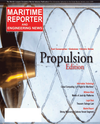
Page 27: of Maritime Reporter Magazine (September 2011)
Marine Propulsion Annual
Read this page in Pdf, Flash or Html5 edition of September 2011 Maritime Reporter Magazine
CS EFFCENC A PEPE, PCESSES & SMA S In operations, more emphasis must belaid on well trained crews, processes and smart tools to reduce the costs of theproducts and services offered, and to re- duce the capital employed. Processes are usually optimied on a continuing basis. And demands on crews are changing too. This is also due to the fact that crew sies have been reduced significantly in the last years. According to the Company of Master Mariners of Canada, they have gone from about 50 a ship to an average of less than half that, with some of the bigger ships operatingwith crews of fewer than 20. The situa- tion today means that ever more complex systems aboard the ships must be oper- ated by fewer crew members. But even with small crews, ships must be kept in top condition so as to avoid any unneces- sary downtime or costly repairs. That?s where Cloud Computing comes in. Cloud-based software may be the an- swer to those seeking to reduce opera- tional costs and minimie capital employed. We all know, employing smart tools and state-of-the-art software can improve efficiency. This is particularly important for technical management soft-ware such as planned maintenance, pro- curement and crewing. Such software must ensure all relevant people aboard or ashore are provided with the right level of information whenever they need it. For example, crew members must be able to plan their work in detail (what to do, when and how to do it) and report back to shore; staff ashore need the cor- rect information (performance data, run-ning hours, purchase requests etc.) at theclick of a button; and management must be able to compare, analye and bench- mark data across the fleet. The informa- tion must be available on-time and in one place to ensure data integrity. Cloud- based software performs exceptionally well on these and more requirements.Cloud Coputing is not a new tech- nology, its a new way of deliering coputing resources et?s look at the underlying technology of cloud-based software such as software as a service (SaaS). With SaaS, we?re not talking about a new technology. The SaaS concept is based on the idea to provide, support and run software via the Internet. So companies starting to employ SaaS will not have to change technology; they?ll just make use of a new way of ac- cessing computing. Then the importance of SaaS on aglobal basis In August 2010, IDC (a global market intelligence firm) said that SaaS will overtake traditional software in 201. They went further by saying that nearly 85 of new software firms com- ing to the market will offer products in the SaaS model. Another analyst, artner Inc., said that the SaaS market will total almost 11 bil- lion in 2011. These are impressive figures underpinning the fact that SaaS and cloud computing are more than a highly ac-cepted IT trend, they?re reality. SAAS ESUS ADNA N-PEMSE SSEMS The popularity of SaaS is steadily in-creasing because it reduces costs andsimplifies deployment. With SaaS, the software provider can support many customers with a single version of a product. This approach al- lows customers to scale as fast as needed without replacing IT infrastructure oradding IT staff. A SaaS application means there is onecentral server and one central database. All employees share the same database, all employees have access to the same current information (within their accessrights).September 2011www.marinelink.com 27On-premise Software SaaS delivery model The software is purchased upfront and integrated into the IT SaaS suppliers provide customers access to the software via the landscape of the company.internet. The software is owned by the customer.The software is not owned by the customer; its owned by the SaaS provider. The software is deployed, managed and supported as well as The services noted on the left are offered by the SaaS provider as maintained by dedicated inhouse IT personnel.part of the subscription fee. The customer provides the inhouse infrastructure to support the The SaaS provider is responsible for maintenance, upgrades, software, such as servers, hardware, networks and security measures.support and security of the software and infrastructure. Its the customers decision whether or not to utilize the latest version The software provider makes available the latest vers ion of the of the software. If so, additional costs are incurred.software to all its customers, at no additional costs.

 26
26

 28
28
